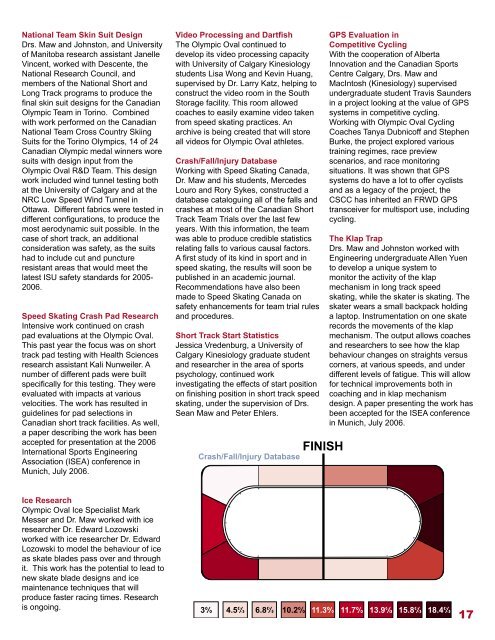Annual Review - Olympic Oval - University of Calgary
Annual Review - Olympic Oval - University of Calgary
Annual Review - Olympic Oval - University of Calgary
You also want an ePaper? Increase the reach of your titles
YUMPU automatically turns print PDFs into web optimized ePapers that Google loves.
National Team Skin Suit Design<br />
Drs. Maw and Johnston, and <strong>University</strong><br />
<strong>of</strong> Manitoba research assistant Janelle<br />
Vincent, worked with Descente, the<br />
National Research Council, and<br />
members <strong>of</strong> the National Short and<br />
Long Track programs to produce the<br />
final skin suit designs for the Canadian<br />
<strong>Olympic</strong> Team in Torino. Combined<br />
with work performed on the Canadian<br />
National Team Cross Country Skiing<br />
Suits for the Torino <strong>Olympic</strong>s, 14 <strong>of</strong> 24<br />
Canadian <strong>Olympic</strong> medal winners wore<br />
suits with design input from the<br />
<strong>Olympic</strong> <strong>Oval</strong> R&D Team. This design<br />
work included wind tunnel testing both<br />
at the <strong>University</strong> <strong>of</strong> <strong>Calgary</strong> and at the<br />
NRC Low Speed Wind Tunnel in<br />
Ottawa. Different fabrics were tested in<br />
different configurations, to produce the<br />
most aerodynamic suit possible. In the<br />
case <strong>of</strong> short track, an additional<br />
consideration was safety, as the suits<br />
had to include cut and puncture<br />
resistant areas that would meet the<br />
latest ISU safety standards for 2005-<br />
2006.<br />
Speed Skating Crash Pad Research<br />
Intensive work continued on crash<br />
pad evaluations at the <strong>Olympic</strong> <strong>Oval</strong>.<br />
This past year the focus was on short<br />
track pad testing with Health Sciences<br />
research assistant Kali Nunweiler. A<br />
number <strong>of</strong> different pads were built<br />
specifically for this testing. They were<br />
evaluated with impacts at various<br />
velocities. The work has resulted in<br />
guidelines for pad selections in<br />
Canadian short track facilities. As well,<br />
a paper describing the work has been<br />
accepted for presentation at the 2006<br />
International Sports Engineering<br />
Association (ISEA) conference in<br />
Munich, July 2006.<br />
Video Processing and Dartfish<br />
The <strong>Olympic</strong> <strong>Oval</strong> continued to<br />
develop its video processing capacity<br />
with <strong>University</strong> <strong>of</strong> <strong>Calgary</strong> Kinesiology<br />
students Lisa Wong and Kevin Huang,<br />
supervised by Dr. Larry Katz, helping to<br />
construct the video room in the South<br />
Storage facility. This room allowed<br />
coaches to easily examine video taken<br />
from speed skating practices. An<br />
archive is being created that will store<br />
all videos for <strong>Olympic</strong> <strong>Oval</strong> athletes.<br />
Crash/Fall/Injury Database<br />
Working with Speed Skating Canada,<br />
Dr. Maw and his students, Mercedes<br />
Louro and Rory Sykes, constructed a<br />
database cataloguing all <strong>of</strong> the falls and<br />
crashes at most <strong>of</strong> the Canadian Short<br />
Track Team Trials over the last few<br />
years. With this information, the team<br />
was able to produce credible statistics<br />
relating falls to various causal factors.<br />
A first study <strong>of</strong> its kind in sport and in<br />
speed skating, the results will soon be<br />
published in an academic journal.<br />
Recommendations have also been<br />
made to Speed Skating Canada on<br />
safety enhancements for team trial rules<br />
and procedures.<br />
Short Track Start Statistics<br />
Jessica Vredenburg, a <strong>University</strong> <strong>of</strong><br />
<strong>Calgary</strong> Kinesiology graduate student<br />
and researcher in the area <strong>of</strong> sports<br />
psychology, continued work<br />
investigating the effects <strong>of</strong> start position<br />
on finishing position in short track speed<br />
skating, under the supervision <strong>of</strong> Drs.<br />
Sean Maw and Peter Ehlers.<br />
Crash/Fall/Injury Database<br />
GPS Evaluation in<br />
Competitive Cycling<br />
With the cooperation <strong>of</strong> Alberta<br />
Innovation and the Canadian Sports<br />
Centre <strong>Calgary</strong>, Drs. Maw and<br />
MacIntosh (Kinesiology) supervised<br />
undergraduate student Travis Saunders<br />
in a project looking at the value <strong>of</strong> GPS<br />
systems in competitive cycling.<br />
Working with <strong>Olympic</strong> <strong>Oval</strong> Cycling<br />
Coaches Tanya Dubnic<strong>of</strong>f and Stephen<br />
Burke, the project explored various<br />
training regimes, race preview<br />
scenarios, and race monitoring<br />
situations. It was shown that GPS<br />
systems do have a lot to <strong>of</strong>fer cyclists<br />
and as a legacy <strong>of</strong> the project, the<br />
CSCC has inherited an FRWD GPS<br />
transceiver for multisport use, including<br />
cycling.<br />
The Klap Trap<br />
Drs. Maw and Johnston worked with<br />
Engineering undergraduate Allen Yuen<br />
to develop a unique system to<br />
monitor the activity <strong>of</strong> the klap<br />
mechanism in long track speed<br />
skating, while the skater is skating. The<br />
skater wears a small backpack holding<br />
a laptop. Instrumentation on one skate<br />
records the movements <strong>of</strong> the klap<br />
mechanism. The output allows coaches<br />
and researchers to see how the klap<br />
behaviour changes on straights versus<br />
corners, at various speeds, and under<br />
different levels <strong>of</strong> fatigue. This will allow<br />
for technical improvements both in<br />
coaching and in klap mechanism<br />
design. A paper presenting the work has<br />
been accepted for the ISEA conference<br />
in Munich, July 2006.<br />
Ice Research<br />
<strong>Olympic</strong> <strong>Oval</strong> Ice Specialist Mark<br />
Messer and Dr. Maw worked with ice<br />
researcher Dr. Edward Lozowski<br />
worked with ice researcher Dr. Edward<br />
Lozowski to model the behaviour <strong>of</strong> ice<br />
as skate blades pass over and through<br />
it. This work has the potential to lead to<br />
new skate blade designs and ice<br />
maintenance techniques that will<br />
produce faster racing times. Research<br />
is ongoing.<br />
17









